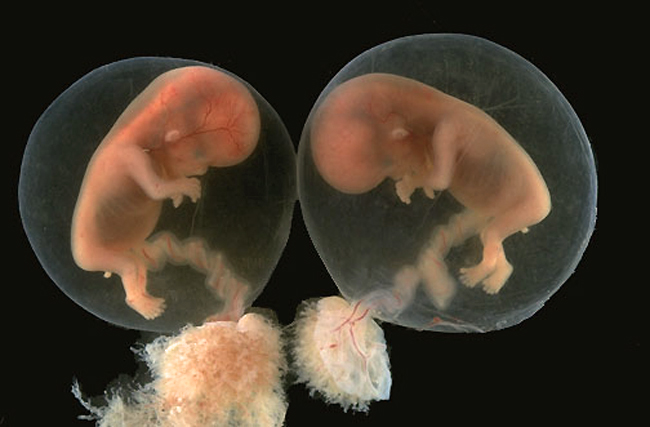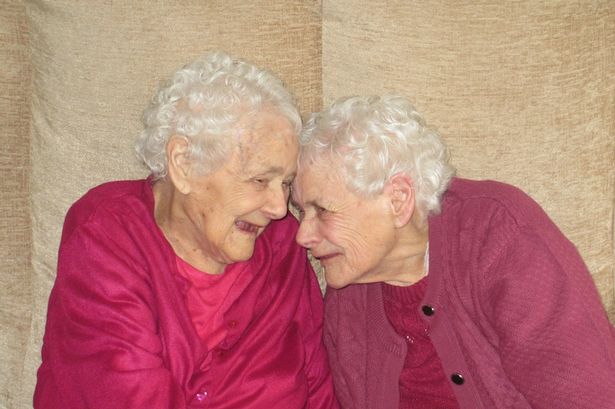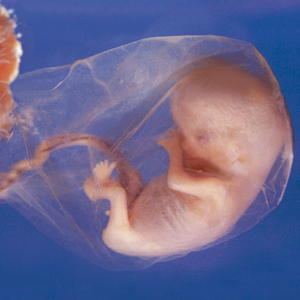Two's Company
How much do you know about twins and how they develop? Are you a twin yourself or are their twins in your family? Here are some quick facts

- Worldwide there are at least 125 million living multiples
- Taller women are more likely to have twins
- C-section births are more common with twins
- The odds of having identical twins is about 3 ½ in 1000
- The average time between the delivery of the first and second twin is 17 minutes
- Nigeria has the highest rates of multiples, while China has one of the lowest
- Up to 22 % of twins are left-handed. In the non-twin population the number is just under 10%.
- If mothers conceive fraternal twins naturally, they have a 1 in 3,000 chance of conceiving another set of fraternal twins
- More than half of twins are born slightly premature (before 37 weeks). A twin’s average birth weight is 5.5 pounds.
- A full 10-15% percent of singleton births may begin as twins. The loss of a twin in early pregnancy is called “vanishing twin syndrome”.
- In Ireland, the twinning rate for 2010 was 16.7 per 1,000 maternities. Multiple births included 1,240 sets of twins and 24 sets of triplets.
- The scientific study of twins is known as "gemellology." The word twin is probably derived from an ancient German word twine, which means 'two together'.
Sources: Blott and Amato, Pregnancy Day by Day, quoted at
Sources: TwinsUK http://www.twinsuk.co.uk/twinstips/18/144/multiple-birth-statistics,-facts-&-trivia/having-twins-or-triplets---interesting-&-fun-facts/; U.S. Centers for Disease Control
- www.cdc.gov;
- ESRI https://www.esri.ie/news_events/latest_press_releases/perinatal_statistics_repo_4/index.xml
Famous Twins
- John and Edward Grimes otherwise known as Jedward
- Models and actresses Mary Kate and Ashley Olsen
- US Track and Field Olympians Alvin and Calvin Harrison
 |
 |
Twins Do Run in the Family!
There is a gene that will increase the chances that the mum will release multiple eggs during her monthly cycle. This increases the chances she will give birth to fraternal twins (the non-identical kind produced from separate eggs). To date there is no known gene associated with identical twins (born when one egg splits in half). The tendency to twins can skip a generation if the male inherits this ‘twin’ gene and passes it along to one of his daughters!
Twins Create Their Own Language
Scientists even have a name for it - idioglossia - the language created and shared between about 40% of twins. The Institute of General Linguistics published research that found this statistic and theorised that twins use each other as models for learning words. Usually - but not always - the twin dialect will disappear as twins gain more vocabulary words and begin school. Authors Denise and Heather Allan (identical twins who wrote Twin Connections: Stories That Celebrate the Mysterious Bond Behind Twins) write: “We speak to each other in a language no one else can understand, nor can we enlighten them. We didn’t realize this until we were 6 or 7 years old when someone pointed it out.”
Talking Twin Babies
11 month old twins dancing to Daddy’s guitar
Still Dancing One Year Later
Twin Bonding begins in-utero
Researchers at the University of Padova in Italy have studied 3D ultrasounds of five sets of twins in utero. As early as 14 weeks, twins were observed reaching out for each other. At 18 weeks, they stroked each other often and were in physical contact 30% of the time. Twins were very gentle, amazingly, stroking each other’s delicate eyes. Previous research also shows that twins socialise with each other just hours after birth.
During a London study, identical twins were even discovered fighting in the womb! In the crowded single placenta, they kick-boxed and wiggled around for more space.
Twins keep surprising us...!
Diet is linked to having twins
The Journal of Reproductive Medicine published a study that showed non-vegans are five times more likely than vegans to have twins, and that women who consume dairy products are more likely to have twins. The Lancet published that the protein IGF (insulin growth factor) is 13 times higher in women who consume dairy than in vegans. IGF increases the ovaries’ reaction to follicle stimulating hormone. Research also shows that older women, obese women, and breastfeeding moms are more likely to have twins.
Identical Twins... aren't completely identical
If you know identical twins, you’ll know they look very similar but are not carbon copies. A study published in the Proceedings of the National Academy of Sciences reports that dietary habits, chemical exposure and other factors cause identical twins to look less alike over time, and of course they can have completely different personalities. Although they have the same DNA, their bodies will not necessarily act the same way, physiologically and medically - a study from Duke University found that when one identical twin in his late 70’s has Alzheimer’s disease, the other twin only has it about 40% of the time.
World's Oldest Twins
At the time of writing, the oldest twins still alive are Florence Davies and Glenys Thomas, who were born in 1911.

Mothers of Twins live longer
University of Utah researchers pored over birth records from 1800 and 1970, and found that mothers of twins live longer than mothers without twins. And instead of gaining 25-35 pounds as in a singleton pregnancy, mothers of twins gain 35-45 pounds! Most consider it worth the weight!
Source: ‘Twin Facts: 20 Wonderful and Wacky Facts about Twins,’
Looking at the science...
In nature, human babies are usually singletons. How does the wondrous anomaly of twin or multiple births take place in nature? Basically,
- Identical (monozygotic) twins are formed from a fertilised egg cell that splits. They are identical because that egg cell is fertilised by one sperm cell so they have identical DNA.
- They can split at the diploid stage (days 1-3), at the early blastocyst stage (days 4-6), or the late blastocyst stage (days 7-9).
- If they split early, they will develop in a separate amniotic sac and placenta; if later, they will share the same amniotic sac and placenta.
- Identical twins are not genetically determined; they are a miracle of nature
- Fraternal twins are genetically determined. The mother of fraternal twins has a genetic tendency to release two egg cells during ovulation rather than one.
- Fraternal twins develop when these two egg cells are fertilised by two separate sperm cells. They do not have identical DNA, and often are different sexes.
- Fraternal twins always develop separately, with different amniotic fluid and placenta
Some rarer cases of twins:
- Mirror Image twins result when the fertilised egg splits late in the embryonic stage, ie around 9 - 12 days. The twins may display reversed assymetry, as if one is looking in a mirror - for example, if one is right handed, the other is left handed, their dental structure, or even their organs may be mirror-imaged, so that some are in the wrong place (situs inversus). The later the fertilised egg splits, the higher the risk of the twins being conjoined.
- There is no specific test for determining if twins are mirror-image.
- Conjoined twins ("Siamese") are those that are joined at birth occurring in as few as one in 200,000 births. They derive from one egg that for unknown reasons has failed to divide fully into identical twins.
- Polar Body or half identical twins occur when one egg splits in two before fertilisation. Each half is then fertilized by a separate sperm. These twins share 75% of their DNA.
Monozygotic twin births occur all over the world at a rate of 3.5 per 1000 births. Dizygotic twin births range from 6.7/1000 births in Japan, to a high of 40/1000 births in Nigeria. Due to increased maternal age, the twinning rate is increasing rapidly.
- Source: Society of Obstetricians and Gynecologists of Canada, http://sogc.org/publications/multiple-birth/
Birth for twins
The moment of birth can occasionally be tense for twins. This video shows a Caesarean section to deliver twin babies. Notice the second baby needs help getting its first good cry out:
National Geographics famous Twins in the Womb
Fraternal twin boys moving on ultrasound
Siamese or Conjoined Twins
What are conjoined (Siamese) twins?
Conjoined twins are born once in every 200,000 live births. Up to 60% of them are stillborn. Overall, less than 25% percent survive infancy. Approximately 70% of conjoined twins are females, and they have better survival chances than males (for unknown reasons).
Conjoined twins split later in pregnancy than other twins (the first few weeks after conception) and share the same amniotic fluid and placenta. The splitting process is incomplete and two conjoined foetuses result.
Today, conjoined twins can be separated. This is a serious and risky decision. Those joined at the sacrum (base of the spine) have a 68% chance of survival, while those joined at the heart do not survive separation. Since 1950, at least one twin has survived separation about 75% of the time. Surgery typically requires intensive spinal rehabilitation of the column and back muscles.
Source: University of Maryland Medical Center, “Conjoined Twin Facts,” retrieved at
These formerly conjoined twins just turned 10:
These two twins, Abby and Brittany Hensel, embrace their conjoined life; their journey through childhood, adolescence and now young adulthood has been featured on many TV programmes:
Extremely rare twins... twice!!
For Alison Spooner and her partner Dean Durrant's offspring have defied the odds - not once, but twice.
Seven years after having one black twin and one white twin, the 27-year-old mother has given birth to a second set of twins with different coloured skin at odds of one in 500,000. When the couple's first daughters arrived in 2001, they were astonished to see that Lauren had her mother's blue eyes and red hair, while her twin Hayleigh had dark skin and hair, like her father, Dean.
So when Miss Spooner, from Fleet, in Hampshire, found out she was pregnant again in 2014, her friends and family joked that they ought to take a bet out on the same thing happening again.
Doctors who delivered the sisters early, because of fears for their health, were relieved to find them well, but also amazed that the second set of twin girls were born with different skin tones. As her parents discovered when the girls were laid side by side in the hospital cot, Miya resembles her father and Leah has inherited her mother's looks.
It is rare enough for two sets of twins to be born to the same parents, but the chances of them inheriting different skin and hair colour from their mother and father are just two in a million.





